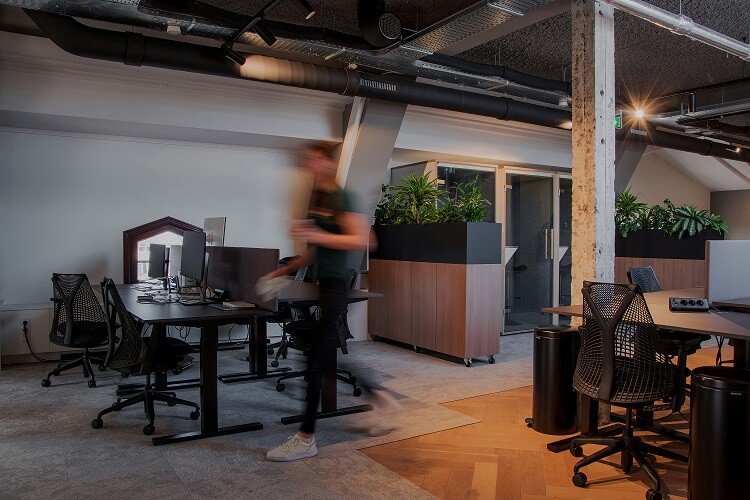The shift to remote work has brought many benefits, but it also comes with challenges, especially when it comes to health and productivity. Many remote workers spend long hours sitting at a desk. This can lead to back pain, fatigue, and trouble staying focused. Fortunately, standing desks are helping solve these problems. By allowing workers to alternate between sitting and standing, these desks improve health and boost productivity.
In this article, we’ll explore how standing desks are helping remote workers stay healthy and productive. We’ll look at the science behind them, the benefits they offer, and how they improve work performance.
Health Challenges of Remote Work
Working from home often means sitting for long periods. Whether it’s at a desk, kitchen table, or couch, remote workers tend to stay in one position for hours. Unfortunately, sitting for too long can cause health problems. Studies show that long periods of sitting are linked to obesity, heart disease, and back pain.
For remote workers, sitting all day can lead to stiffness, discomfort, and fatigue. Blood flow slows down, causing muscles to tighten. This can make it harder to focus and stay engaged with work. These health issues can affect both physical well-being and job performance.

How Standing Desks Help
Standing desks offer an easy way to break up long hours of sitting. By giving workers the option to stand, these desks improve circulation, reduce discomfort, and promote better posture. Here are the key health benefits of using a standing desk:
1. Reduces Back and Neck Pain
Sitting for long hours puts strain on the spine, leading to back and neck pain. A standing desk encourages better posture and reduces the pressure on the spine. Standing engages core muscles, which helps support the back and neck. As a result, remote workers often feel less discomfort and experience better overall posture.
2. Improves Circulation and Increases Energy
Standing helps improve circulation by allowing blood to flow more easily to the legs, heart, and brain. This helps remote workers stay more energized throughout the day. By standing regularly, workers can avoid the sluggishness that often comes from sitting too long. Better circulation can also reduce the risk of problems like blood clots and varicose veins.
3. Promotes Better Posture
A standing desk encourages a more natural body position. When standing, remote workers are less likely to slouch or hunch over their desks. This helps avoid the poor posture that comes with sitting for long periods. Good posture prevents long-term back and neck pain, which can help workers stay focused and productive.
Boosting Productivity with a Standing Desk
The benefits of a standing desk go beyond health. Standing desks also help boost productivity. Here’s how:
1. Improves Focus and Mental Clarity
Standing increases blood flow to the brain, which improves focus and mental clarity. Remote workers who use standing desks report feeling more alert and productive. Research shows that standing can help improve memory and problem-solving skills. This is especially helpful when tackling complex tasks or brainstorming new ideas.
2. Reduces Fatigue
Standing desks help reduce the physical and mental fatigue that comes with sitting all day. When workers stand, they feel less tired and more energized. This can help improve overall work output. Workers can stay focused and avoid the afternoon slump that often happens after sitting for hours.
3. Increases Flexibility
A standing desk gives workers the flexibility to switch between sitting and standing. This variety helps avoid the feeling of being stuck in one position for too long. It also allows workers to take short breaks and move around, which can refresh the body and mind. This flexibility can make work feel less monotonous and help boost creativity and focus.
Tips for Using a Standing Desk Effectively
While standing desks offer many benefits, it’s important to use them correctly. Here are a few tips for remote workers to get the most out of their standing desk:
- Alternate between sitting and standing: It’s important to switch between the two positions throughout the day. Aim to stand for 20-30 minutes every hour.
- Maintain good posture: Keep your screen at eye level and your arms at a 90-degree angle when typing. This helps avoid strain.
- Use an anti-fatigue mat: If you’re standing for long periods, use a soft mat to reduce pressure on your feet and legs.
Conclusion: Achieving Balance with a Standing Desk
Standing desks are helping remote workers improve their health and productivity. These desks reduce back and neck pain, increase energy, and promote better posture. They also help boost focus, reduce fatigue, and provide the flexibility to move during the workday. By switching between sitting and standing, workers can stay healthy and productive, without the strain of sitting all day.
If you’re a remote worker looking to improve your work-life balance, a standing desk may be just what you need. It can help you feel better, focus more, and get more done each day. With all the benefits they offer, standing desks are quickly becoming an essential tool for remote workers seeking a healthier, more productive workday.
